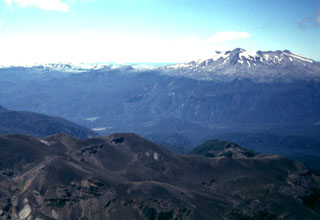Report on Puyehue-Cordon Caulle (Chile) — 24 April-30 April 2024
Smithsonian Institution / US Geological Survey
Weekly Volcanic Activity Report, 24 April-30 April 2024
Managing Editor: Sally Sennert.
Please cite this report as:
Global Volcanism Program, 2024. Report on Puyehue-Cordon Caulle (Chile) (Sennert, S, ed.). Weekly Volcanic Activity Report, 24 April-30 April 2024. Smithsonian Institution and US Geological Survey.
Puyehue-Cordon Caulle
Chile
40.59°S, 72.117°W; summit elev. 2236 m
All times are local (unless otherwise noted)
SERNAGEOMIN reported that inflation had been detected at the Puyehue-Cordón Caulle volcanic complex since 2011 based on GNSS satellite and radar data. The inflation is centered about 6 km WNW of the 2011 eruption vents. The rate of inflation had increased during the first few months of 2024, reaching a maximum average of 2.4 cm per month, which was the highest rate detected since GNSS equipment was installed in 2017. Seismicity began to slightly increase in mid-2020 and was characterized by volcano-tectonic and hybrid events from a shallow source near the 2011 vents. Gas emissions rose from the 2011 vents and were nearly 90 degrees Celsius. The Alert Level was raised to Yellow (the second lowest color on a four-color scale) on 26 April based on the high deformation rates.
Geological Summary. The Puyehue-Cordón Caulle volcanic complex (PCCVC) is a large NW-SE-trending late-Pleistocene to Holocene basaltic-to-rhyolitic transverse volcanic chain SE of Lago Ranco. The 1799-m-high Pleistocene Cordillera Nevada caldera lies at the NW end, separated from Puyehue stratovolcano at the SE end by the Cordón Caulle fissure complex. The Pleistocene Mencheca volcano with Holocene flank cones lies NE of Puyehue. The basaltic-to-rhyolitic Puyehue volcano is the most geochemically diverse of the PCCVC. The flat-topped, 2236-m-high volcano was constructed above a 5-km-wide caldera and is capped by a 2.4-km-wide Holocene summit caldera. Lava flows and domes of mostly rhyolitic composition are found on the E flank. Historical eruptions originally attributed to Puyehue, including major eruptions in 1921-22 and 1960, are now known to be from the Cordón Caulle rift zone. The Cordón Caulle geothermal area, occupying a 6 x 13 km wide volcano-tectonic depression, is the largest active geothermal area of the southern Andes volcanic zone.
Source: Servicio Nacional de Geología y Minería (SERNAGEOMIN)

